Dear Artist,
I’ve always been suspect of historical painter’s palettes. One reason is that a lot of my old ones are around and none are typical, nor are they dated. They were put aside because they were an irredeemable mess. Further, it would be difficult to link any of them with the particular colours I was using at the time. When researchers determine the pigments Manet was using in 1873, he may indeed have been having a bad day and just discarded the offending thing. Further, palettes purported to be in use the day an artist died are not reliable either. If I thought I might croak on Thursday, I might just squeeze out the damnedest things. Truth is, creative folks are often trying something new, even on their last day.
Nevertheless, we love to analyze old palettes. There’s even a healthy market for the things. One thing for sure, there’s a wide range of ways to set up and use a palette. Whistler believed proper palette organization was the key to all the good stuff. Seurat, as we might imagine, kept his mainly primary pigments in a pretty rigid and unwavering order. For him, Mr. Black was not allowed on the job. Gauguin, for all his verbal enthusiasm for pure colour, made an unsightly pileup of sullied pigment.
Delacroix used his laboriously-prepared palette to fire his painterly enthusiasm. Rumour has it that he took his palette to bed for quiet periods of pre-mixing. Most, but not all, painters line up their colours at the top and mix below. Some squeeze out differently every time. Vincent van Gogh defined a painter as “Someone who knows how to find the greys of nature on the palette.” Monet maintained that a painter needs to be as familiar with his palette as a pianist is to the keys on her piano. He recommended not having to take one’s eyes from the painting. Rembrandt worked with a small palette of mostly earth colours. Painters of the 17th Century had considerably fewer pigments to put on their boards. Next time you’re looking at a Rembrandt, you may see a message in that.
Best regards,
Robert
PS: “If the colour is wrong, everything is wrong: just as, if you are singing, and sing false notes, it does not matter how true your words are.” (John Ruskin)
Esoterica: Daubs on palettes are an artist’s unwitting footprints. Lucy Davies in a Sunday Telegraph Seven Magazine quotes from Vincent’s 1882 letter to his brother Theo: “There are but three fundamental colours — red, yellow, and blue; ‘composites’ are orange, green, and purple. By adding black and some white one gets the endless varieties of greys — red grey, yellow-grey, blue-grey, green-grey, orange-grey, violet-grey. It is impossible to say, for instance, how many green-greys there are; there is an endless variety. But the whole chemistry of colours is not more complicated than those few simple rules.” How well stated, and yet how difficult it is to extract beauty from the little daubs on those mahogany boards.
This letter was originally published as “Tales the palettes tell” on June 29, 2010.
Have you considered a Premium Artist Listing? With each letter, an artist is featured at the bottom of this page. The Premium Artist Listings are a means of connecting artist subscribers through their work. Proceeds from each listing contribute to the production of The Painter’s Keys.
“The first virtue of a painting is that it be a feast for the eyes.” (Eugene Delacroix)
Featured Workshop
A 3 day Non-Objective Painting Workshop with Cat Tesla and Julie Schumer
in Santa Fe, New Mexico
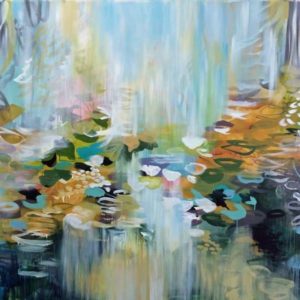 Explore and develop your personal voice in the inspirational environment of Santa Fe. We will explore composition, color, value and how to work on multiples at the same time. Find your own signature with different mark making tools and learn how your marks enliven your paintings. Learn how to harmonize any palette, move from analysis paralysis to painting success and to trust your artistic choices. This intensive 3 day workshop is perfect for the beginning artist who has some experience using acrylic paint.
Explore and develop your personal voice in the inspirational environment of Santa Fe. We will explore composition, color, value and how to work on multiples at the same time. Find your own signature with different mark making tools and learn how your marks enliven your paintings. Learn how to harmonize any palette, move from analysis paralysis to painting success and to trust your artistic choices. This intensive 3 day workshop is perfect for the beginning artist who has some experience using acrylic paint.
August 14, 15, and 16
9 am to 4:30 pm
$950 Bring a friend and save $50 each
https://artbycat.com/page/1-Workshops-Prints.html
Featured Artist
Sometimes we see what no one looks for–images that have waited for us to find them. If we are lucky, these images will wait while we try to capture them with paint on canvas. They will probably change as we reach for them. I believe that if we clearly and honestly record what we see, we will be surprised, enriched, and sometimes stunned by what we’ve found.
There is almost always a narrative in my paintings as I believe that a story may be introduced in a scene. The viewer must fill in the before and after with unique eyes and experience, but enough can be presented to set a challenging stage if the work is successful.
Along with being a visual story teller, I’ve been called a colorist, surrealist, patternist, and sometimes a texturist. I’m an Atlanta artist–an oil painter for over twenty-five years–with a studio in Brookhaven. I love working with oils because each painting session results in a new revelation of what they might do. There is a mystical quality to each painting and each day for me.

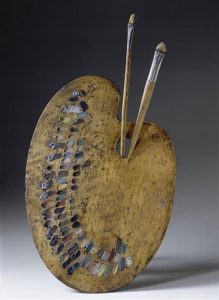
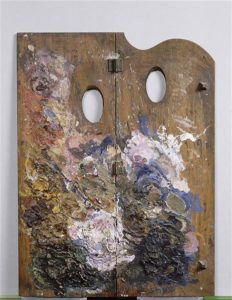
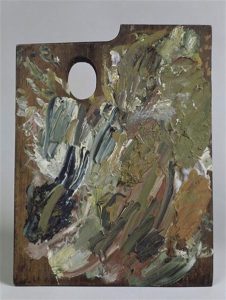
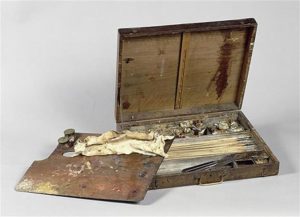
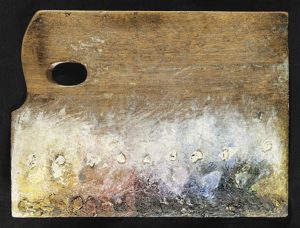
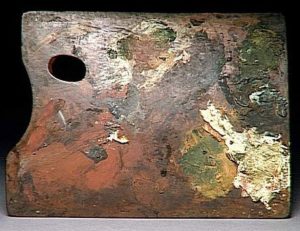
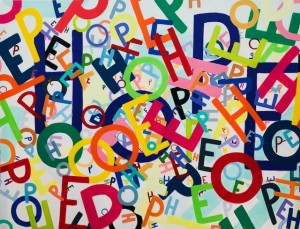



16 Comments
Great story about palettes. I love thinking about Delacroix tucked in warm and cozy mixing colours in bed. I have never thought of trying this and can only imagine the state of his sheets! I have used disposable palettes for years now… but there is often a reference in a photograph of work in progress. I never thought about it as being a fingerprint. Mine would likely be identifiable I suppose. Almost never any black and ordered on three sides the same way every time. Yellow to red with a violet possibly beside the deepest red bottom right. Phyllo blue in semi quarantine in the top left. Earth tones across the top with raw umber next to the phyllo blue and then going lighter. The blues going down the left side and then three dabs of white in the middle and I am ready to paint. Not all pigments get put out every time but they always get put in the same place. I want the muscle memory to guide my mixing and it have to search for the pigment. I am left handed and I am suspicious that my ordering of things reflects this. Whatever it is, it works for me. Happy painting everyone! And thanks as a.ways Sarah.
I thoroughly enjoyed reading about various artists’ palettes, from past history. What hit close to home was the quote from Delacroix concerning the first aim of painting is “that it be a feast for the eyes”. I am an adherent of that; so my palette changes almost always, depending on the mood of the moment in time. I usually start with a black canvas from which colours emerge intuitively. I never know what will emerge, making one paint mark followed by a second and then a next, till the myriad of marks start to come together in harmonious unity. I confess that yellow ochre tends to be a constant in my underpainting, along with white, due to the black cover. From there on, other colours are introduced. I work in acrylic, so am able to use a palette over and over . The paint daubs and mixtures build up into thick hardened patches. Then it is time to start on a new palette. At this point, once the palette is dried, I peel off those blobs of paint which I call acrylic skins and proceed, at a later date, to recycle, as it were, those skins by using them to create a new, mostly vivid painting.
Marjorie Moeser, Toronto
Very interesting. I would have loved to see your and your dad’s palettes in there!
Yes, that would be fabulous to see, I agree
My palette is a large sheet of thick glass, making it super easy to clean-either with wet paint or dry-a little spritz of water and my razor scraper glides right through dry paint. Any paint I don’t use up I cover up with a sheet of plastic wrap, which I can also use for mono-printing. Always put the colors on from warm to cool with black and white at the opposite outer edges (black by the prussian blue, white by the cadmium red. Any earth colors get thrown on if needed. There won’t be any wooden palette, or disposable paper palettes or paper plates, or anything to give clues as to how I arrived at those final colors on the canvas. I can hardly believe that Vincent used 3 primaries plus black and white-having seen plenty his work in person….color mixing and harmony is so impossibly hard!! He truly was a genius!
Connie,
I like your palette from warm to cool w/ black and white.
I use watercolors, so I have two dishes, one dish for black tones (5 tones of black) and another dish for primaries and white.
I wash my dishes after I paint with the colors, I use fresh squeezed colors each time I paint.
I heard from another artist friend that it is not worth to use old watercolor colors that I have used in the dishes for a previous painting. Is it true?
Yes, old paint cannot be reconstituted to the deep original color. Also, wipe out your color with paper towels and throw away. Rinsing the palette in water contaminates our water supply.
I reconstitute watercolour paint all the time maybe to my own demise but all my paintings are done with a portable palette air tight Mijello on which I have squeezed out paint and let dry over night in an open palette so they won’t run when I carry it to class or out plein air. I mist them with water just before using them.
I personally haven’t used watercolor paints since 38 yrs ago when my son was 4yrs old…I had just finished a commissioned watercolor painting and while.it was drying, my little darling spilled water on it…Yes…The painting was gone!!!… Since then, I use watered down acrylic paint for a watercolor painting…If it gets wet, it’s still there!!! Carolyn McBride Tampa, FL
Vincent was usually short of money and probably had to learn to use what he could buy with a minimum amount of money. Gauguin ha the same problem. I once did a copy of a Gauguin and arrived at painting her lips. Unusual color, I mixed 2 colors he had to be using on his palette at the time and hit it dead on. I had a similar experience another time doing a copy of another Gauguin.
Well…there’s 4 great caveates to digital painting:
– to save or not to save. One fell swoop (click) and a palette can be shared with the world or hit “delete” and bingo…its gone
– nothing goes into the water supply
– or a landfill
– saves on paper towels
A truly eco system saver!
And according to David Hockney, no other medium has such instant, direct color!
I never clean my palette until the painting is complete. I paint in oils and my work takes days, even weeks to complete. This means that the paint often dries before I finish the work. In this respect the palette becomes a record of what is happening on the canvas and helps me remix and match the colors and tonal qualities that I have previously used.
I use mirror for my palette.
My website: http://www.jemarmo.com
“If the colour is wrong, everything is wrong: just as, if you are singing, and sing false notes, it does not matter how true your words are.” (John Ruskin)
How could a color be wrong? A color couldn’t be compared to a false note. I don’t think that the word ‘wrong’ could be applied to art.
Are we confusing “inaccurate” with “wrong”? We can and do get away with using colors that are not accurate to the subject. A false musical note injects discord. When we inject a discord into our painting by use of an inappropriate color, the result is often not what we sought. It is wrong and may perhaps serve only to confuse the viewer and draw the eye away from the intended center of interest. The color is right if it achieves the intended purpose and wrong if it does not, regardless of its accuracy.